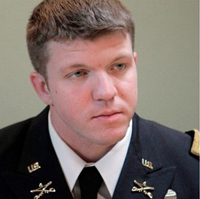Circle of Absurdity: Killing the Islamists We Create

The U.S. military remains mired in countless wars in the Greater Middle East. Ironically ŌĆō and tragically ŌĆō it tends to combat Islamists that Washington either armed or birthed.
We, Americans, truly are a strange lot. Our government in Washington ŌĆō ostensibly representative of "We the People" ŌĆō speaks of peace, but wages endless war, prattles on about "freedom," but backs absolute monarchs and authoritarian strongmen the world over. A bipartisan array of politicians warns of the evils of radical Islamic (though Islamist is more accurate) terrorism; and yet, truthfully, the US once supported and/or funded those same extremists not too long ago. In some cases, and certain circumstances, it backs them still; until, that is, all those guns are turned on the US military, or those fighters threaten WashingtonŌĆÖs (ever shifting) "interests."
Perhaps, one imagines, there are lessons here: be careful who you arm; be careful where you meddle; todayŌĆÖs "friends" are, all too often, tomorrowŌĆÖs enemies; and, in the turbulent Middle East, sometimes less is more.
Washington would do well to remember that before its next ŌĆō and there will be a next ŌĆō intervention.
Russia, it seems, is once again center stage in the Middle East. Congressmen and Senators ŌĆō usually neocons or hawkish liberal interventionists ŌĆō warnthat Russia is "running wild," or will "win" Syria. In fact, they argue, the US military must stay put in Syria, Iraq, and elsewhere, indefinitely one presumes, to block potential Russian gains. US troops must also back assorted proxies, even some nefarious characters, in order to deter Russian efforts in the region.
The whole presumption, of course, is flawed and simplistic. We are led to believe geopolitics is a simple zero-sum game, whereby any "gain" for Russia (or Iran) is somehow a "loss" for the United States. Much evil, and plenty of mistakes, stem from such warped assumptions.
The thing is, the historian in me has seen this movie before, and knows it ends badly. A generation raised on post-9/11 alarmism regarding terrorism and the (admittedly real) dangers of political Islam, might be surprised to know the US once backed many of these very same Islamist zealots in the name of countering the then Soviet Union. It was fear of the looming Russian bear ŌĆō and the competition for oil ŌĆō that first brought the US military into the region in a serious way.
US Central Command (CENTCOM), which controls all US servicemen in the Greater Mideast, was only formed in the early 1980s, largely in response to the Soviet intervention in Afghanistan (1979) and the ostensible threat of a broader Soviet armored assault straight south to the Persian Gulf. Of course, no such danger ever really existed; nor was it very plausible. Nonetheless, Washington took action, which heralded just the most extreme version of the sad, recurring, tales of US support for Islamists. Fighters, who, more often than not, would later turn their guns, bombs, (and box cutters on 9/11!) on America.
The US supported, funded, and armed (including with surface to air missiles) the Afghan mujahedeen ŌĆō many of whom were Islamist zealots ŌĆō throughout the 1980s. It also backed its long time frenemy, Saudi Arabia, which acted aspatron for the Arab extremists who flocked to the Afghan jihad. The variousmujahedeen, many of whom were rather extreme, morphed into warlord militias after the defeat of the Soviets. The excesses of these venal warlords in the 1990s, and the refugee crisis that landed millions of unemployed youths in various squalid camps, led directly to rise of the Taliban. Many of the TalibanŌĆÖs senior leaders had previously fought the Soviets, often with US weapons or support.
We all know the next part of the sordid tale: Arab volunteers who had fought the Soviets in Afghanistan, returned to the Mideast radicalized, confident, and ŌĆō after US troops were stationed in Saudi Arabia following IraqŌĆÖs invasion of Kuwait in 1990 ŌĆō increasing anti-American. A popular leader of these "Afghan Arabs," as they were called, was one young Saudi named Osama bin Laden.
YouŌĆÖd think contemporary policymakers would learn from and heed this warning. By and large, though, they have not.
US support for the Saudis continues, and, in fact, stretched way back to the 1940s ŌĆō in a devilŌĆÖs bargain of oil for arms and influence that remains in effect. Even in conflicts that preceded the Soviet war in Afghanistan (1979-1988), the U.S.-backed Saudis tended to support the forces of Islam (often of the SaudisŌĆÖ own extreme Wahhabi variety) against secular Arab nationalist and/or socialist regimes from North Africa to South Asia.
The US, frankly, was then more concerned with "radical," secular, Arab nationalists such as EgyptŌĆÖs Gamal Abdel Nasser. In YemenŌĆÖs Civil War in the 1960s, American-backed Saudis supported religious, royalist forces against the secular nationalists backed by Nasser. Furthermore, throughout that era ŌĆō and even today ŌĆō our Saudi "allies" invested billions in mosque construction and the propagation of their own intolerant brand of Wahhabi Islam across the Greater Middle East.
Think on that for just a second. The US spent most of the Cold War backing religious kingdoms and organizations against the very, albeit authoritarian, secular movements we now purport to favor. Furthermore, the Saudis ŌĆō second only to Israel among AmericaŌĆÖs regional allies ŌĆō were busy spreading the toxic Islamism weŌĆÖve spent the last 17 years combating.
Worse still, since 9/11 (and remember 15/19 of those hijackers were Saudis) the US track record is just as dismal, with AmericaŌĆÖs military all too often battling Islamists we once armed or helped create. In 2001, there existed only one truly transnational terror threat group with the aspiration and capability to attack the US homeland: Al Qaeda. More than a decade and a half later, such Islamist groups have only proliferated in response to US military interventions
Most of the groups the US military now fights ŌĆō and IŌĆÖve spent a careercombating ŌĆō are an outgrowth of, or reaction against, American actions in the region. Talk about counterproductive. It borders on the absurd! Consider just a few examples:
- In Iraq, today, the US combats the remnants of ISIS. ISIS didnŌĆÖt even exist on 9/11. There were no Iraqis on those planes, and Saddam had no serious relationship with Al Qaeda. The local AQ franchise only grew and gathered recruits in response to the wide perception of US neo-imperialism. Then, years later, ISIS, the most radical offshoot of Al Qaeda in Iraq, was birthed in that ultimate incubator of Islamist extremism: US military prisons. The rest, so they say, is history.
- In Yemen, the US is complicit in the Saudi terror bombing and blockade. In addition to killing civilians, instigating a famine, and contributing to the spread of cholera, this war has only empowered the main AQ affiliate in the area: Al Qaeda in the Arabian Peninsula (AQAP). While US planes are refueling Saudi jets which bomb local Houthi "rebels," the campaign all but ignores AQAP. If anything, theyŌĆÖre bombing the wrong people! This group, mind you, has been labeled the Al Qaeda affiliate most dangerous to the homeland.
- In 2011, President Obama authorized what heŌĆÖd later label a "shit show:" bombing and regime change in Libya. Muammar "Mad Dog" Gaddafi was certainly an unsavory character, but toppling him without a plan for the day after only further empowered regional Islamism. The country split into rival statelets, tribal fighters migrated south with a veritable arsenal of weapons, and too often joined or backed West African Islamist militias. And, well, you guessed it, US troops are now fighting, and dying, combating those very groups in Mali, Cameroon, and Niger.
- In Syria, the US is mopping up ISIS and trapped between several hostile actors: Turkey, Russia, Iran, AssadŌĆÖs regime, and various non-ISIS Islamist groups. The crazy thing is, our Saudi frenemies sent boatloads of cash and weapons to many of these Islamist fighters. In fact, even US arms ŌĆō intended for so-called moderate rebels ŌĆō ended up in the hands of the local Al Qaeda franchise, the Nusra Front.
The disturbing truth is, that I, and most professional soldiers in the post-9/11 military, have almost never fought the enemy whoŌĆÖd attacked the US in the first place: Al Qaeda, that is. For the most part, US troops spent the last two decades combating Afghan farm boys, African tribal militias, local Arab Islamists, and various franchises of ISIS ŌĆō the true FrankensteinŌĆÖs monster of the global war on terror.
I recount this dismal record for a specific purpose: to warn. To warn against shortsighted interventions or carelessly working through regional proxies.
TodayŌĆÖs convenient friend is too often tomorrowŌĆÖs sworn enemy.
We reap what we sow, and, in the stormy Middle East, more often than not, the US sows chaos.
Danny Sjursen is a US Army officer and regular contributor to Antiwar.com. He served combat tours with reconnaissance units in Iraq and Afghanistan and later taught history at his alma mater, West Point. He is the author of a memoir and critical analysis of the Iraq War, Ghostriders of Baghdad: Soldiers, Civilians, and the Myth of the Surge. Follow him on Twitter at @SkepticalVet.
[Note: The views expressed in this article are those of the author, expressed in an unofficial capacity, and do not reflect the official policy or position of the Department of the Army, Department of Defense, or the U.S. government.]
Copyright 2018 Danny Sjursen
Read more by Maj. Danny Sjursen
- Cleaning House, Enabling War ŌĆō April 5th, 2018
- Unbridgeable Gap: Who We Were and Who We Thought We Were ŌĆō April 2nd, 2018
- Where Have You Gone, George McGovern? ŌĆō March 28th, 2018
- The March We Need: A March for PeaceŌĆ” or, at least, De-Escalation ŌĆō March 26th, 2018
- Trump, 14 EU Nations Expel Russian Diplomats and Recall Ambassadors ŌĆō March 26th, 2018



